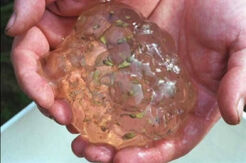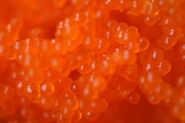
|
"Hardly any wetland bird is more easily identified than the Roseate Spoonbill"
This article contains information relating to a former cryptid. Former cryptids are either cryptids proven to exist, or those that are no longer considered cryptids. |
NPR (National Public Radio) and Newser have reported that the enigmatic orange substance that descended on an Alaskan village last week has been identified as the eggs of an unknown animal.
A mysterious orange goo that appeared on the shore of the small Alaskan village of Kivalinahas have been identified as “millions of microscopic eggs filled with fatty droplets,” but researchers claim they still don’t know what the eggs might hatch, or if they are toxic. Janet Mitchell, City Administrator for Kivalina, had this to say about the goo:
“[It was] found several miles inland in the fresh water Wulik River, the orange material turned gooey and gave off a gaseous odor. But scooped out of the ocean, the substance had no odor and was light to the touch, with the feel of baby oil.”
The eggs were also found on at least one roof and in buckets set all over the village to collect rain water. City Councilwoman Frances Douglas, a 44-year native of the village, said the gooey, slimy substance was widely spread in streaks along the Wulik River and the lagoon, which is a half mile wide and six miles long. Orangey water was reported from as far away as the village of Buckland, 150 miles southeast of Kivalina.
Douglas remembers temperatures were colder in her childhood, gradually rising over the years. She wonders if climate change might have had something to do with the invasion of the eggs, which she estimated were evident in the village in a volume that was: “in excess of a thousand gallons, easily.”
Even though the eggs appear to have dissipated, Mitchell — and other villagers — expressed concern about the eggs effect on her village’s food supplies and delicate ecosystem:
“It seems to be all gone, but if they’re microscopic eggs, who’s to say they’re not still in the river?”

Kivalina Isle
The village of Kivalina is an Inupiat Eskimo community located at the tip of an 8-mile barrier reef on Alaska’s northwest coast. Its 374 residents live largely off the land, and many are concerned about the effect on the local wildlife and plants from a substance never seen there before.
Orange-tinted water was reported in areas around Kivalina, as well. And reports that the cloud of eggs might have killed a lagoon full minnows brought new questions over whether the eggs might be toxic, or if the sheer volume of the eggs may have deprived the minnows of oxygen. In Juneau, National Oceanic and Atmospheric Administration (NOAA) scientist Jeep Rice said Monday:
“It was easy to see cellular structure surrounding the lipid droplet, and to identify this as ‘animal.’ We have determined these are small invertebrate eggs, although we cannot tell which species.”

Starjelly
Scientists also don’t know why the unidentified eggs suddenly emerged on the shores of Kivalina last week. Villagers say they’ve never seen such a phenomenon before. According to NOAA spokeswoman Julie Speegle:
“We’ll probably find some clues, but we’ll likely never have a definitive answer on that.”
Samples are being sent to a NOAA laboratory in Charleston, S.C., for further analysis. The Alaska Department of Environmental Conservation also sent samples Monday to the Institute for Marine Science at the University of Alaska Fairbanks.
It’s worth noting that there have been anomalous “biological storms” in the past, such as the infamous red rain or “Blood rain” that fell on Kerala, India in 2001 or the hundreds examples of as yet unclassified viscous “purple globs” or “star jelly” that have mysteriously fallen to the Earth and displayed distinctly biological properties.
On the 7th of March, 2012, an article was posted announcing they had identified the mystery material. Crustacean eggs and Spruce Labrador Tea Needle Rust. [1]
Gallery[]

